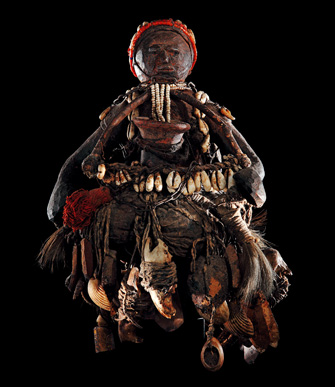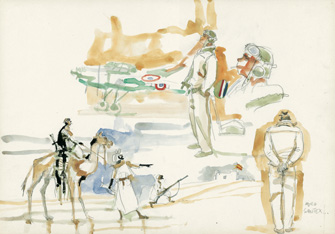 |
|
Canine reception in a neighborhood hotel. Photo © Martin Parr / Magnum Photos-Institut des cultures d’Islam |
What a great idea: Invite renowned British photographer Martin Parr to be the artist in residence at a little-known Islamic cultural center hidden away in Paris’s Goutte …
 |
|
Canine reception in a neighborhood hotel. Photo © Martin Parr / Magnum Photos-Institut des cultures d’Islam |
The Goutte d’Or!: L’Institut des Cultures d’Islam Invite Martin Parr
What a great idea: Invite renowned British photographer Martin Parr to be the artist in residence at a little-known Islamic cultural center hidden away in Paris’s Goutte d’Or (meaning “drop of gold,” for the color of the white wine that used to be produced there), a neighborhood near Montmartre with a large proportion of Muslim residents and one of the highest population densities in the world.
Parr’s name was enough to bring crowds to the Institut des Cultures d’Islam for the opening of the exhibition last week, attended by the artist himself. While Parr was vocally displeased about and frustrated by French privacy laws, which make it illegal to take a picture of an individual without his or her express permission (and very few of the people he encountered on the street
 |
|
Eric, charcutier at the Cochon d’Or in Paris for 17 years. Photo © Martin Parr / Magnum Photos-Institut des Cultures d’Islam |
were willing to give permission), he was thrilled that he had not only been allowed to take photos of local Muslims praying in the street (the neighborhood’s two mosques are so small that they overflow into the street during Friday prayers) and was even allowed to photograph women praying in the mosque.
Parr’s photos of the area are far less irreverent than his images of, for example, British people on holiday, which are often laugh-out-loud funny, but they still exhibit his wry humor, great color sense and affection for all that is kitsch (the two photos shown on this page are fine examples). His shots of those people who did give their permission to be photographed are often extremely touching, among them an image of an older woman living in a nursing home all dressed up and brighted-eyed for the photographer, and another of women taking a literacy course at the institute sharing a traditional galette du roi, with one wearing the crown that always comes with the Epiphany pastry, making her queen for a day.
The Institut des Cultures d’Islam is a fine place – with its courtyard, exhibition space, tearoom and active cultural program of concerts, films and lectures – but it will soon move into even finer premises: a new home in two spaces is currently being built for it by the city of Paris in the same neighborhood.
Institut des Cultures d’Islam: 19-23, rue Léon, 75018 Paris. Métro: Château Rouge. Tel.: 01 53 09 99 84. Admission: free. Open Wednesday-Sunday, 3pm-8pm, Saturday, 10am-8pm. Through July 2. www.institut-cultures-islam.org
Vodun: African Voodoo
The Fondation Cartier’s new exhibition, “Vodun” (African Voodoo), is both fascinating and frustrating. It presents a collection of sometimes handsome, sometimes extremely rustic but always intriguing and powerful West African (mostly from Benin) voodoo sculptures, but offers no wall text or labels to explain to visitors what they are looking at. Each work is presented on its own as a work of art – in the basement each has its own glass case, as if it were a precious jewel – without any reference to its original context or meaning.
Luckily, the foundation does provide a booklet, which requires some study to find clues to
 |
|
Fon voodoo sculpture from Benin. Photo © Yuji Ono |
the meaning of these fascinating objects called bocios (“empowered cadavers”). Wooden sculptures in the form of humans, they symbolize the owner’s cadaver and are bedecked with various combinations of such objects as padlocks, keys, cowrie shells, animal skulls, teeth, bones, twine, gourds, feathers, fabric and “sacrificial patina” made of clay, palm oil, blood and other materials. Some are pierced with pegs and some are double-headed or double-bodied.
The West African cult of voodoo traveled with the slave trade to the Americas, where it mingled with other religions, notably Catholicism, and lost the sculptural tradition of the bocios. Its adherents believed that talismans like those on show here allowed them to communicate with the invisible spirit world – ranging from major deities to spirits inhabiting streams, trees and rocks – and offering them protection and the ability to cast spells on adversaries.
The makeup and meaning of each bocio is highly varied and individual – binding with twine may refer to anger or imprisonment, for instance, while cowrie shells might represent longing or desire. The curators seem to be trying to downplay the negative aspects of the use of the bocios, but they were certainly often used with the intention of causing harm – an animal’s jawbone attached with a padlock is intended to provoke the death of an adversary, for example, while binding on the legs could provoke paralysis in an enemy. Pegs are also used to harm a rival by causing illness or accidents in the part of the body that is pierced. Double-headed bocios provide protection and help ward off evil spells.
The exhibition’s emphasis on the bocios’ aesthetic value rather than their meaning (even though the press kit quotes Patrick Vilaire, who notes that “there is no functional quest for beauty” in the making of a bocio) reflects the approach of the man who collected most of them, Jacques Kerchache, who was among those behind the creation of Paris’s Musée de Quai Branly.
Do see this exhibition, but to better understand it, first read the booklet, particularly pages eight and nine, where some clues to the meaning of the figures are finally given, although in the end these strange objects will always retain their share of mystery.
Fondation Cartier pour l’Art Contemporain: 261, boulevard Raspail, 75014 Paris. Métro: Raspail. Tel.: 01 42 18 56 50. Open Tuesday, 11 a.m.-10 p.m.; Wednesday-Sunday, 11 a.m.-8 p.m. Admission: €6.50. Through January 10. http://fondation.cartier.com
Le Voyage Imaginaire de Hugo Pratt
While Hugo Pratt (1927-1995) may not be a household name in France, almost everyone has heard of Corto Maltese, a series of literary bandes dessinées (comic books) almost as popular as Tintin and Astérix. Pratt, the creator of Corto Maltese, is the subject of a new exhibition at the Pinacothèque de Paris, which was hastily mounted a few months ahead of time to replace a planned show on Mayan masks that had been cancelled following diplomatic tensions between France and Mexico.
You do not need to be a fan of Corto Maltese to enjoy this exhibition. As a matter of fact, you do not need to know anything at all about it. While diehard fans will be delighted to see all of the original plates (in Italian) for the eponymous
 |
|
“Adieu Saint-Ex” (1994), a watercolor honoring Antoine de Saint-Exupéry by Hugo Pratt. © Cong SA, Lausanne |
hero’s first adventure, La Ballade de la Mer Salée, the real strength of the exhibition lies in the 160 watercolors on show. Some of them are simply magnificent.
The show is divided into six themes: islands and oceans, deserts, soldiers, cities, women and Indians, the subjects Pratt valued above all others and which constituted the core of his imaginative world. Deeply influenced by writers Joseph Conrad, Robert Louis Stevenson, Herman Melville and Antoine de Saint-Exupéry, Pratt shared their love of travel and fascination with the sea. With their brigantines under full sail, seagulls gliding in the sky and ocean stretching out to the horizon, Pratt’s marine paintings are the highlight of the exhibition. His love of literature and poetry can also be seen in the colorful watercolors he painted to illustrate some of Rudyard Kipling’s poems.
Corto Maltese’s adventures intermingle fictional characters with historical characters. Over the course of his adventures, Corto Maltese meets, among others, Rasputin, Arthur Rimbaud and Louise Brooks. This blend of fiction – at times bordering on fantasy – and history is one of the characteristics of Pratt’s works.
Born in 1927 in Rimini, Italy, Pratt spent most of his childhood in Venice. At the age of 14, he left Italy for Abyssinia (present-day Ethiopia), then an Italian colony. There he worked with his father for the Italian Africa police. His stay in Africa had a major impact on his life. From then on, he traveled the world, living in different cities and earning a living as a professional draftsman.
Corto Maltese is a merchant navy captain and, in many ways, a typical romantic hero. Like Pratt, this handsome, lonesome and rather mysterious sailor spends his life traveling around the world. The similarities between Pratt and his fictional double are striking. Corto Maltese’s father is an English sailor and his mother a Gypsy from Gibraltar. Pratt’s father was an Italian soldier of English origin and his mother an Italian woman of Jewish descent. Pratt wanted his hero to have roots in both Mediterranean and Anglo culture, as he did.
This is the first time since Pratt’s death that a major retrospective of his artwork has been held in Paris. The goal of the exhibition is to show the skeptics that he was an artist with a capital A. After having seen the exhibition, I doubt that many would disagree.
La Pinacothèque de Paris: 28, place de la Madeleine, Paris 75008. Métro: Madeleine. Open Monday-Sunday, 10:30am-7:30pm, until 9:30pm on Wednesday. Admission: €10. Through August 21. www.pinacotheque.com
Please support Paris Update by ordering books from Paris Update’s Amazon store at no extra cost. Click on your preferred Amazon location: U.K., France, U.S.
Reader Reaction: Click here to respond to this article (your response may be published on this page and is subject to editing).
More reviews of Paris art shows.
© 2011 Paris Update
